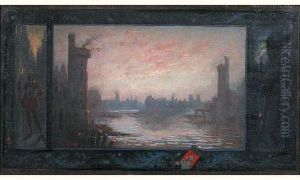Louis Jouve Paintings
Louis Jouve, born in 1887 in Pierrelatte, Drôme, France, was a distinguished French painter known for his contributions to the art world in the early to mid-20th century. Although not as widely recognized as some of his contemporaries, Jouve's work played a significant role in the development of modern French painting, showcasing a unique blend of traditional craftsmanship and innovative artistic expression.
Jouve's early life was marked by an intense passion for art, which led him to pursue formal education in the field. He studied at the École des Beaux-Arts in Paris, where he was exposed to the works of the great masters, as well as contemporary movements that were beginning to take shape. His education and experiences in the bustling art scene of Paris deeply influenced his artistic direction.
Throughout his career, Jouve developed a distinctive style that was characterized by its vivid use of color and dynamic compositions. He was particularly known for his landscapes and portraits, which often captured the essence of French rural and urban life with a keen eye for detail and a profound sense of emotion. Jouve's work was a reflection of his personal observations and experiences, imbued with a sense of realism that was both poignant and captivating.
Despite facing the challenges of two World Wars and the shifting trends in the art world, Jouve remained committed to his craft, continually evolving his techniques and exploring new themes. He exhibited his work in various prestigious venues, gaining recognition and respect among his peers and art lovers alike. His contributions to French art were appreciated during his lifetime, and he received several awards and honors for his work.
Louis Jouve passed away in 1968, leaving behind a legacy that continues to inspire artists and art enthusiasts. His paintings are a testament to his skill and vision, offering a glimpse into the world through his eyes. Today, Jouve's works are held in private collections and museums, where they are celebrated for their beauty, depth, and artistic integrity. His life and work remain an important part of the narrative of French art history, exemplifying the enduring spirit of creativity and innovation.
